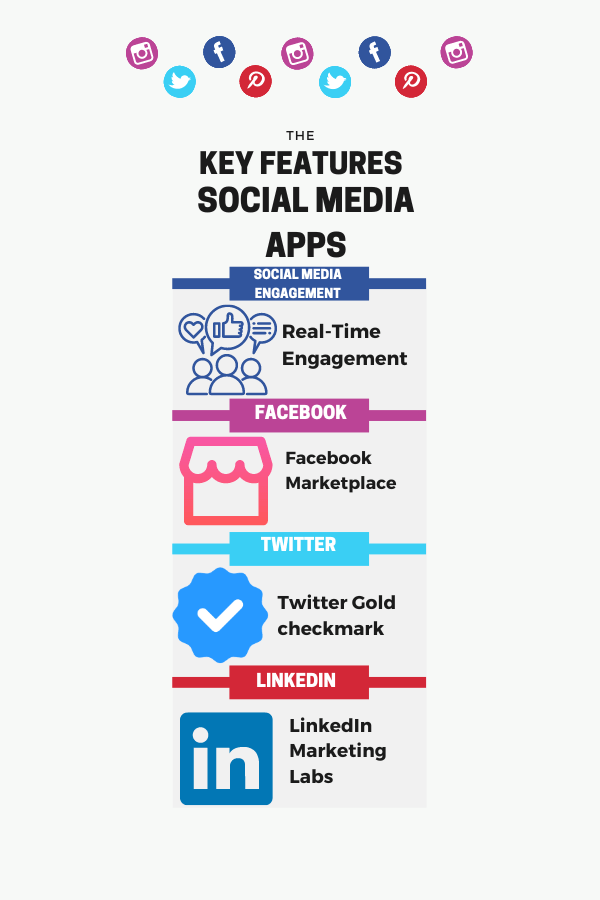Nowadays, businesses utilize social media for marketing their products and services in the start stage, it is used to do brand awareness, drive website traffic or increase followers count on their social media page, generate leads from them and make the followers brand advocacy and increase sales is the process that businesses do in social media.
So in this blog, we will explore five new ways to leverage your business using features of social media apps.
Key features of social media app
The business has multiple social media platforms like Facebook, Instagram, Twitter and LinkedIn. These are the major apps in the market, but we also have other minor apps like Pinterest, Snapchat, and Spotify, which are minor apps to market their business.

Live Streaming & stories:
Live streaming:
Live streaming allows users to broadcast real-time video content to their followers. Live streaming is available on websites like Facebook, YouTube, and Instagram.
Stories:
Stories are short-lived posts that vanish in a day. They are prominently displayed at the top of users’ feeds and frequently contain pictures or brief videos. Popular platforms for stories include Facebook, WhatsApp, Snapchat, Instagram, and others.
Example: how businesses can leverage social media strategy
Behind-the-scenes content:
Give your audience a peek behind the curtain by live-streaming footage of your business operations, product development process, or team meetings. This offers transparency and humanizes your brand.
Product launches and announcements:
Use live streaming to unveil new products, announce upcoming events or promotions, or share important company updates. This creates excitement and generates buzz around your brand.
Shoppable product tags:
Shoppable posts and product tagging features allow businesses to tag products within their social media posts, making it easier for users to discover and purchase items directly from the platform.
Shoppable posts streamline the purchasing process, allowing users to shop for products without leaving the social media platform. This convenience improves the overall user experience and reduces friction in the buying journey.
How businesses can leverage social media strategy
Eligibility Check:
Ensure that your business account meets the eligibility criteria for shoppable posts on social media platforms.
Product Catalog Setup:
Create a product catalog or integrate your existing e-commerce platform with social media to sync product inventory and details.
Enable Shopping Features:
Activate the shoppable posts or product tagging feature in your account settings to enable direct purchasing functionality.
Interactive Polls and Surveys:
Tips for creating engaging polls:
Keep It Concise:
To increase participation, keep polls and surveys brief and targeted. Refrain from providing too many options or questions for your audience.
Be Clear and Specific:
Communicate the purpose and context of the poll or survey to ensure respondents understand what they are asked.
Offer Incentives:
Consider offering incentives such as discounts, giveaways, or exclusive content to incentivize participation and increase response rates.
Conclusion:
Staying informed about updates and announcements from social media platforms is crucial for businesses to remain up-to-date with the latest features and functionalities. By closely monitoring these developments, companies can identify new opportunities to enhance their social media presence and engage with their audience more meaningfully.
Once new features are rolled out, businesses must experiment and test them thoroughly. This experimentation allows businesses to understand how the features work and how they can be effectively utilized to achieve specific marketing objectives. Companies can determine what resonates best with their audience and drives the desired results by testing different approaches and strategies.
FAQ’s
In terms of social media marketing, what do you do?
Which five marketing pillars are they?
What is the purpose of a hashtag?
On social media platforms, a hashtag is used as a metadata tag to classify material and make it easier for people to find interest in a particular topic. The ‘#’ symbol precedes hashtags and can be used to join or start conversations, participate in trending topics, or organize content around specific themes.
What distinguishes SMM from SMO?
In order to improve visibility, engagement, and brand presence on social media platforms, social media optimization, or SMO for short, comprises enhancing social media accounts, content, and activities.
Social media marketing, or SMM for short, is the use of sponsored content, paid advertising, and other promotional techniques to reach a target audience and accomplish particular marketing objectives on social media platforms.

